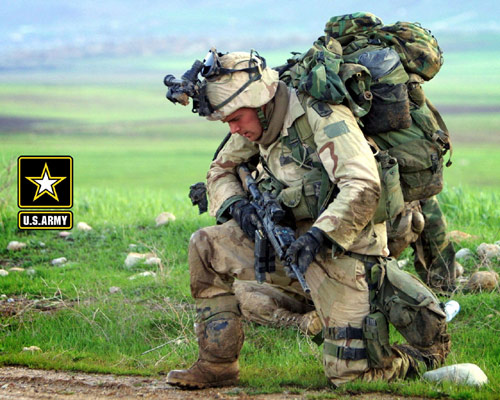當(dāng)前位置: Language Tips> 雙語(yǔ)新聞
US Army studying replacing thousands of grunts with robots
分享到

|
During remarks at the Army Aviation Symposium in Arlington, Va., on Jan. 15, Cone quietly dropped a bomb. The Army, he said, is considering the feasibility of shrinking the size of the brigade combat team from about 4,000 soldiers to 3,000 over the coming years, and replacing the lost soldiers with robots and unmanned platforms. “I’ve got clear guidance to think about what if you could robotically perform some of the tasks in terms of maneuverability, in terms of the future of the force,” he said, adding that he also has “clear guidance to rethink” the size of the nine-man infantry squad. He mentioned using unmanned ground vehicles that would follow manned platforms, which would require less armor and protection, thereby reducing the weight of a brigade combat team. Over the past 12 years of war, “in favor of force protection we’ve sacrificed a lot of things,” he said. “I think we’ve also lost a lot in lethality.” And the Army wants that maneuverability, deployability and firepower back. The Army is already on a path to shrink from 540,000 soldiers to about 490,000 by the end of 2015, and will likely slide further to 420,000 by 2019, according to reports. Cone said his staff is putting together an advisory panel to look at those issues, including fielding a smaller brigade. “Don’t you think 3,000 people is probably enough probably to get by” with increased technological capabilities, he asked. It’s hard to see such a radical change to the makeup of the brigage combat team as anything else than a budget move, borne out of the necessity of cutting the personnel costs that eat up almost half of the service’s total budget. Cone used the Navy as an example of what the Army is trying to do. “When you see the success, frankly, that the Navy has had in terms of lowering the numbers of people on ships, are there functions in the brigade that we could automate — robots or manned/unmanned teaming — and lower the number of people that are involved given the fact that people are our major cost,” he said. Some of Cone’s blue-sky thinking was echoed by Lt. Gen. Keith Walker in a Jan. 6 interview with Defense News. In what Walker called the “deep future” — about the 2030 to 2040 time frame — he said that “we’ll need to fundamentally change the nature of the force, and that would require a breakthrough in science and technology.” While Walker, the commander of the Army Capabilities Integration Center, which oversees much of the Army’s modernization and doctrinal changes, didn’t talk about replacing soldiers with robots, he did say the Army wants to revamp its “tooth-to-tail” ratio, or the number of soldiers performing support functions versus those who actually pull triggers. |
“美國(guó)陸軍正朝著規(guī)模更小、作戰(zhàn)能力更強(qiáng)、機(jī)動(dòng)性更好、反應(yīng)更敏捷的方向發(fā)展。”美國(guó)陸軍訓(xùn)練與條令司令部司令羅伯特?科恩上將表示。至于其規(guī)模縮減的程度和方式,則令人頗感意外。 綜合外國(guó)媒體1月21日?qǐng)?bào)道,美國(guó)陸軍考慮將旅級(jí)戰(zhàn)斗隊(duì)的人數(shù)削減1/4,從目前的4000人減少至3000人,被裁減的士兵由機(jī)器人等無(wú)人平臺(tái)取代。目前,陸軍方面已組建一個(gè)顧問小組對(duì)該計(jì)劃展開研究。 據(jù)美國(guó)《防務(wù)新聞》周刊報(bào)道,美國(guó)陸軍已開始“瘦身”計(jì)劃,將在2015年底把陸軍人數(shù)從54萬(wàn)縮減至49萬(wàn)左右,到2019年時(shí)可能最終減少至42萬(wàn)。 科恩說,隨著現(xiàn)代科技的發(fā)展,3000人規(guī)模的作戰(zhàn)隊(duì)已經(jīng)夠用,“我被明確告知,認(rèn)真考量用機(jī)器人來(lái)執(zhí)行部分任務(wù)的可操作性,以及這對(duì)陸軍部隊(duì)未來(lái)的影響”。此外,他還被要求重新思考是否有必要改變陸軍現(xiàn)行的9人制步兵班編制。 至于有哪些選項(xiàng)已被納入討論范圍,科恩列舉美國(guó)海軍利用科技裁減人員的成功經(jīng)驗(yàn),稱旅級(jí)戰(zhàn)斗隊(duì)的運(yùn)輸?shù)炔糠止δ芸捎蓹C(jī)器人完成,“就像執(zhí)行遠(yuǎn)途補(bǔ)給任務(wù)時(shí),可以將車隊(duì)中的一部分車輛換成無(wú)人駕駛車,它們只需跟著有人駕駛的車前進(jìn)就能完成任務(wù)”。 《防務(wù)新聞》指出,目前人力成本幾乎占到美軍費(fèi)總額的一半,陸軍方面決定對(duì)旅級(jí)戰(zhàn)斗隊(duì)的人員構(gòu)成進(jìn)行“如此激進(jìn)的改革”,其根本原因只可能是適應(yīng)軍方預(yù)算緊縮的現(xiàn)狀。 科恩對(duì)此表示默認(rèn),他舉例稱使用無(wú)人駕駛地面車輛不用考慮人員防護(hù)的問題,既能減少車輛的體積,又能節(jié)省裝甲等防護(hù)成本,從而從整體上降低旅級(jí)戰(zhàn)斗隊(duì)的費(fèi)用。 “在過去12年的戰(zhàn)爭(zhēng)中,為了保護(hù)士兵安全,我們犧牲了很多東西,我認(rèn)為我們也為此損失了不少戰(zhàn)斗力。現(xiàn)在,陸軍想要重新拿回機(jī)動(dòng)性、可部署性和強(qiáng)大火力。” 不過,對(duì)于“用機(jī)器人取代士兵”的計(jì)劃,美國(guó)陸軍中也存在質(zhì)疑的聲音。基思?沃克是美國(guó)陸軍能力集成中心負(fù)責(zé)人,他認(rèn)為到2030年至2040年,美軍的性質(zhì)將從根本上發(fā)生改變,這需要科學(xué)技術(shù)取得突破性進(jìn)展,“并且,美軍有必要改變前線部隊(duì)和后勤支持部隊(duì)的比例,而不是用機(jī)器人取代士兵”。 (來(lái)源:中國(guó)日?qǐng)?bào)網(wǎng)愛新聞iNews) 注:此文為編譯。 |
上一篇 : 曼德拉雕像耳藏銅兔 當(dāng)局不滿要求去掉
下一篇 : 臺(tái)灣之行 那么近那么遠(yuǎn)
分享到
關(guān)注和訂閱


口語(yǔ)
關(guān)于我們 | 聯(lián)系方式 | 招聘信息
電話:8610-84883645
傳真:8610-84883500
Email: languagetips@chinadaily.com.cn